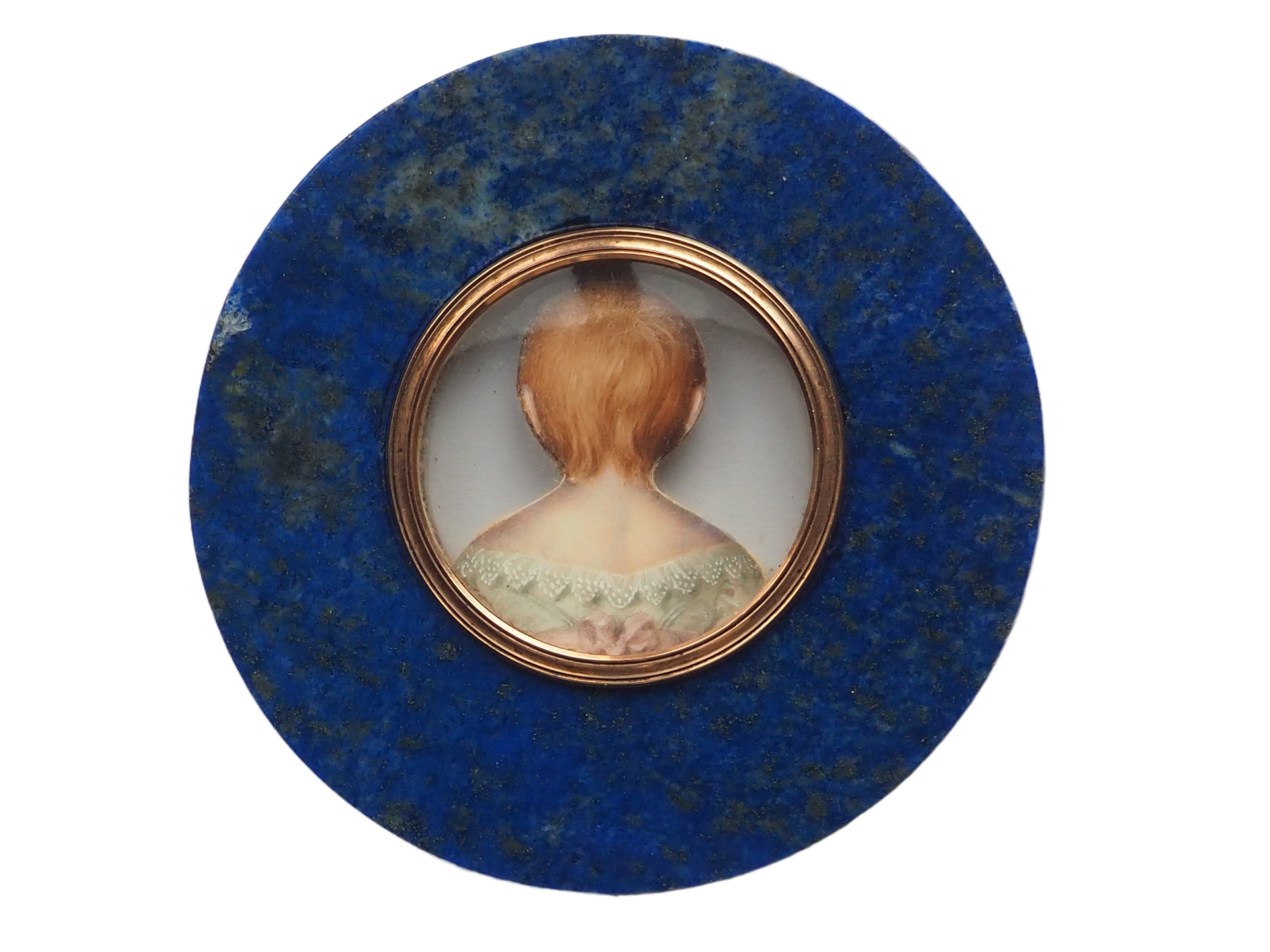NEAPOLITAN SCHOOL
Empire period
Portrait of a Bourbon Princess of Naples
19th century
Watercolor and gouache, round: 3.7 cm.
Gold metal and lapis lazuli frame, 7.7 cm.
Exceptional and rare miniature portrait of a Bourbon princess of Naples cut around the silhouette of the character and also painted on the reverse. A very rare technique that is only found on eight (1) other miniatures.
This object was recently studied by the English art historian Allison Gaudie. Dr. Gaudie emphasizes the historical significance of these portraits in the context of the double marriage that took place in 1802 between the Neapolitan and Spanish Bourbons.
An object commissioned by the Royal Family, possibly painted by one of the Royal Princesses. The daughters of the King of Naples received lessons in drawing and miniature from the Neapolitan miniaturist C. Marsigli.
Excellent original state of preservation.
For other photographs and information, please contact us.
(1)
• Musée Condé, Chantilly (inv. n. OA 1474, Miniatures 158), depicts one of Maria Carolina’s daughters, possibly Empress Maria Theresa or Princess Maria Amelia (later Queen of the French). See N. Garnier-Pelle, N. Lemoine-Bouchard, and B. Pappe, Les miniatures du musée Condé à Chantilly cit., p. 199, cat. 235.
• Portrait of Maria Carolina of Naples, c. 1802, watercolour on ivory with lace, Naples, Museo di San Martino
• Walters Art Museum, Baltimore (inv. n. 38.174), thought to depict Princess Luisa Carlotta of the Two Sicilies (1804-1844)
• Philadelphia Museum of Art (inv. n. 1899-976), depicts an unidentified woman with short hair
• Private collection (Christie’s, London, 25 May 2004, lot 121), depicts Princess María Isabel (wife of Hereditary Prince Francesco).
• Private collection (Sotheby’s, Geneva, 15 November 1995, lot 281), depicts Maria Carolina recto and verso on a heart-shaped ground, with the surrounding area around her silhouette painted in, that is, not ‘cut-out’.
• Musée Condé, Chantilly (inv. n. OA 1449, Miniatures 160), believed to depict either Princess Maria Cristina or Princess Maria Amelia of Naples recto and verso on a diamond-shaped ground, not ‘cut-out’. See N. Garnier-Pelle, N. Lemoine-Bouchard, and B. Pappe, Les miniatures du musée Condé à Chantilly cit., p. 182, cat. 205.
• Private collection (previously recorded as being in the collection of the Earl of Aguiar), by Diego Monroy, c. 1820, depicts an unknown woman recto and verso on an oval ground, not 'cut-out'. See J. Ezquerra del Bayo, Miniature-Portrait Exhibition in Spain, exh. cat.
BIBLIOGRAPHY:
Allison Goudie, MARIA CAROLINA IN MINIATURE: DRESSING FOR A DYNASTIC WEDDING BETWEEN THE NEAPOLITAN AND SPANISH BOURBONS, 1802. p. 311-332; Garnier-Pelle, N. Lemoine-Bouchard, and B. Pappe, Les miniatures du musée Condé à Chantilly cit., p. 199, cat. 235; A. Di Cicco, cat. 3.12, in Galanterie: Objects of luxury and pleasure in Europe between the eighteenth and nineteenth centuries, exh. cat. (Naples, National Museum of Ceramics "Duca di Martina", 27 September 1997 - 26 April 1998), Electa, Naples, 1997, pp. 155-156; A. González-Palacios, Two scenes of conversation in miniature, in A. González-Palacios (ed.), The Temple of Taste: The decorative arts in Italy between classicism and baroque. Rome and the Kingdom of the Two Sicilies, Longanesi, Milan, 1984, vol. 1, pp. 347-348; and A. Gonzalez-Palacios, Family Portraits Dear Memories: One Hundred Years of Royal Relationships Told in an Unusual Collection of Miniatures, «Casa Vogue Antiques», May 1989, n. 4, p. 86.
MUSEUMS:
Musée Condé, Chantilly (inv. n. OA 1474, Miniatures 158);Musée Condé, Chantilly (inv. n. OA 1449, Miniatures 160); Walters Art Museum, Baltimore (inv. n. 38.174); Philadelphia Museum of Art (inv. n. 1899-976); coll. p.






